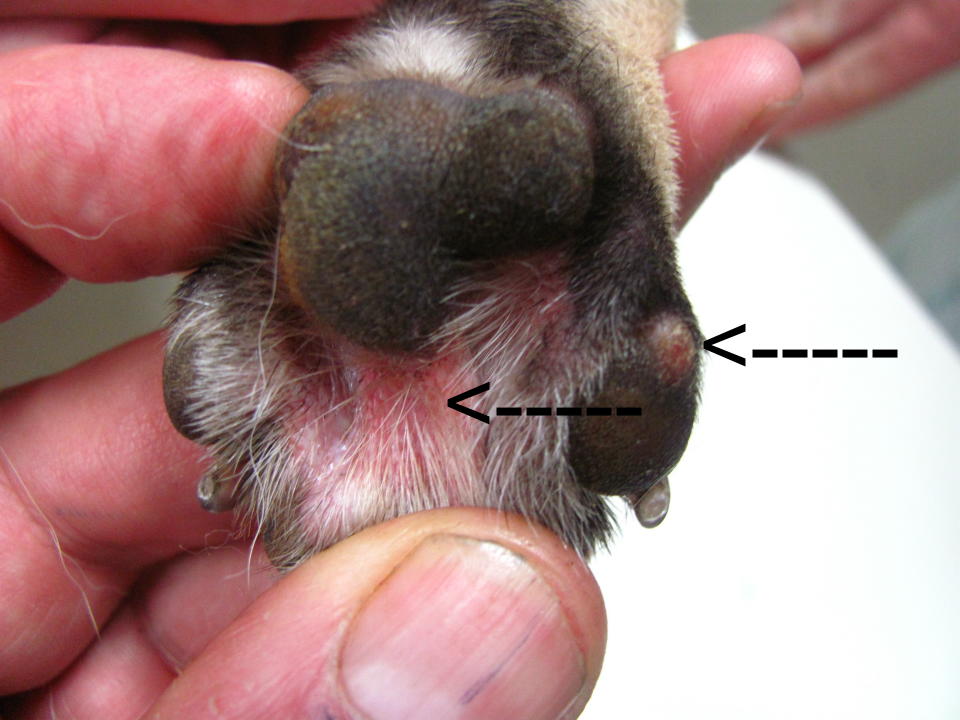Dog Has Red Irritated Paws? What Every Owner Needs to Know
You come home from a walk with your furry best friend, and everything seems normal. Then you notice it – your dog is excessively licking and chewing at their paws. On closer inspection, you see they’re red and inflamed. Seeing your dog in discomfort is never easy, and irritated paws are a common, yet often overlooked, problem for many dog owners. But what’s causing this irritation? Is it a simple allergy, or could it be something more serious?
Just like us, our canine companions can experience a range of skin issues. Red and irritated paws, also known as paw pododermatitis, can be caused by a multitude of factors. Understanding the potential reasons behind your dog's discomfort is the first step in providing them with much-needed relief.
From environmental allergens like pollen, grass, and mold to parasites like fleas and mites, there are several culprits that can irritate your dog's sensitive paws. Food allergies and even underlying medical conditions can also manifest as paw inflammation.
While it's easy to brush off occasional paw licking, persistent redness and irritation should never be ignored. Constant licking can lead to secondary infections, making the problem even more challenging to treat. That's why it's crucial to address this issue head-on and consult with your veterinarian.
In the following sections, we'll delve deeper into the common causes of red, irritated paws in dogs, discuss when professional help is necessary, and provide you with actionable steps to soothe your dog's discomfort and get them back to their happy, playful selves. Remember, a little knowledge can go a long way in ensuring your four-legged friend lives their best, most comfortable life!
Understanding the Causes of Red, Irritated Paws
Determining the underlying cause of your dog's paw irritation is crucial for effective treatment. Here are some common culprits:
1. Allergies:
Just like humans, dogs can suffer from allergies to various substances, including pollen, mold, dust mites, and even certain food ingredients. These allergens can trigger an inflammatory response, leading to itchy, red paws.
2. Parasites:
Fleas, ticks, and mites can cause intense itching and irritation, leading to excessive licking and chewing, which further inflames the skin.
3. Contact Dermatitis:
Irritants like harsh chemicals in cleaning products, pesticides, and even rough surfaces can cause contact dermatitis, resulting in red, irritated paws.
4. Infections:
Bacterial and yeast infections can develop in the moist areas between a dog's paw pads, leading to redness, swelling, and discomfort.
5. Underlying Medical Conditions:
In some cases, red and irritated paws can be a symptom of an underlying medical condition, such as hypothyroidism or autoimmune disorders.
When to Seek Veterinary Care
If your dog's paw irritation is severe, doesn't improve with home remedies, or is accompanied by other symptoms like limping, lethargy, or loss of appetite, it's crucial to seek immediate veterinary care.
Tips for Soothing Your Dog's Irritated Paws
Once you've consulted with your veterinarian and determined the cause of your dog's paw irritation, you can implement some soothing measures:
1. Medicated Shampoos and Ointments:
Your veterinarian may recommend medicated shampoos or ointments to address infections or allergies.
2. Foot Soaks:
Soaking your dog's paws in lukewarm water with Epsom salt or oatmeal can help to reduce inflammation and soothe irritation.
3. Protective Booties:
Consider using protective booties to prevent your dog from licking their paws and to protect their sensitive skin from further irritation.
Preventing Future Problems
Prevention is key to keeping your dog's paws healthy. Here are some proactive measures you can take:
1. Regular Paw Checks:
Make it a habit to check your dog's paws regularly for any signs of redness, swelling, or discharge.
2. Thorough Drying After Walks:
After walks, especially in wet or muddy conditions, ensure you thoroughly dry your dog's paws to prevent moisture buildup, which can create a breeding ground for bacteria and yeast.
3. Regular Grooming:
Keep your dog's nails trimmed and their paw fur trimmed short to prevent matting and moisture trapping.
By understanding the potential causes of red and irritated paws and taking proactive steps to address and prevent this common issue, you can ensure your canine companion enjoys happy, healthy, and comfortable paws for years to come. Remember, your veterinarian is your best resource for diagnosing and treating any health concerns your dog may have. Don't hesitate to reach out for professional guidance to give your furry friend the care they deserve.
Crafting effective tarpaulin layouts a comprehensive guide
Decoding the jpmorgan chase bank routing number maze
Finding solace navigating grief with heafey hoffmann dworak cutler mortuaries

Red Spots On Dogs Belly And Groin | Innovate Stamford Now

How to Treat Common Paw Problems in Dogs | Innovate Stamford Now

Can Dogs Catch Thrush From Humans | Innovate Stamford Now

What Causes Dogs Paws To Swell | Innovate Stamford Now

Looks like a small hole in between toes raised bump with pin hole. Dog | Innovate Stamford Now

Dog Balls Irritated After Grooming | Innovate Stamford Now

Red Paws On Dogs: Causes And Treatments (With FAQs), 50% OFF | Innovate Stamford Now

dog has red irritated paws | Innovate Stamford Now

How Do I Treat My Dogs Red Paws | Innovate Stamford Now

How Do I Clean My Dogs Infected Paws | Innovate Stamford Now

Red spot on top of dog | Innovate Stamford Now
![Crusty Scabs on Dogs: Top Causes and What To Do [Vet Advice]](https://i2.wp.com/seniortailwaggers.com/wp-content/uploads/scabs-possible-skin-infection-2-1024x931.jpg)
Crusty Scabs on Dogs: Top Causes and What To Do [Vet Advice] | Innovate Stamford Now

What Causes Dogs To Have Itchy Feet? Exploring Common Triggers | Innovate Stamford Now

Home Remedies For Dogs With Dry Itchy Skin | Innovate Stamford Now

What can I put on my dog | Innovate Stamford Now